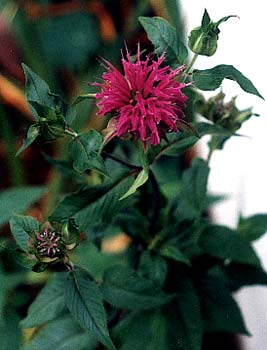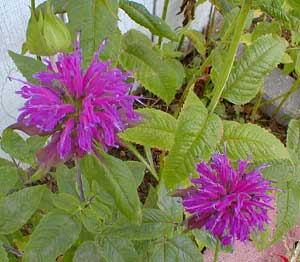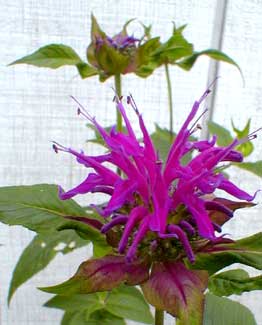
'Marshall's Delight'
Bee Balm
"There is a flower that bees prefer,
And butterflies desire;
To gain the purple democrat
The humming-birds aspire."
-Emily Dickinson
(1830‚1886)
(1830‚1886)
Bee balm, aka bergamot, is a relative of mint. Wild Monarda didyma is known as Scarlet Bergamot, or Oswego Tea because collected by pioneer botanist John Bartram in Ontario where the first peoples used it to make a tonic tea.
The genus was named in honor of Nicolas Bautista Monardes (1508-1588; an earlier date often given for his birth is almost certainly wrong), shown in the woodcut portrait at right.
Monardes was a Spanish physician, son of an Italian bookseller. His 1577 volume Joyfull Newes Out of the New Founde Worlde was the first book to describe tobacco, coca, passion vine, guava, sarsparilla, among other firsts.
 Nicholas never personally visited the Americas, but was involved in mercantile enterprises including importation of medicinal plants, & established a remarkable botanical garden in Seville for the further study of New World plants. A great man in many ways, there is sadly one enormous blight upon his character, in that he held mercantile investments in the slave trade between Africa & the Americas.
Nicholas never personally visited the Americas, but was involved in mercantile enterprises including importation of medicinal plants, & established a remarkable botanical garden in Seville for the further study of New World plants. A great man in many ways, there is sadly one enormous blight upon his character, in that he held mercantile investments in the slave trade between Africa & the Americas.Bee balm's potential for aggressiveness is never so extreme as the closely related Menthes sp. & the great beauty of the flowers makes it a more pleasing perennial than mint, even if it were permitted to get a bit out of hand. Still, because bee balms can occasionally be aggressive, we placed 'Marshall's Delight' in an alley, where it was welcome to spread a great deal. But in three years it did not spread all that much, leaving me with the impression that it isn't at all aggressive.
Its all-summer purple flowers really dress up the alley, which used to be a strip of weeds, but was slowly transformed into a narrow flowery strip, with several persistent bloomers including 'Midnight Blue' Penstemon & another Monarda cultivar that begins blooming at least three weeks earlier than 'Marshall's Delight,' the deep red 'Jacob Kline' Beebalm.
 Monardas are highly susceptible to powdery mildew. Although 'Marshall's Delight' is one of the most resistant, it is nevertheless very apt to be afflicted. In persistantly moist soil, & with some trimming to keep a patch airy, mildew probably will not be too much of a problem. But since ours is growing in an alley that is often a bit dry, the monarda though flourishing is nevertheless subject to stress.
Monardas are highly susceptible to powdery mildew. Although 'Marshall's Delight' is one of the most resistant, it is nevertheless very apt to be afflicted. In persistantly moist soil, & with some trimming to keep a patch airy, mildew probably will not be too much of a problem. But since ours is growing in an alley that is often a bit dry, the monarda though flourishing is nevertheless subject to stress.As summer was turning to autumn (in 2002), our Marshall's Delight did get mildewy. I just cut it to the ground, discarding rather than composting the leaves, & it quickly began to regrow with its wholesome appearance regained. The following year, I periodically sprayed the area with dilute milk, which is a fully organic method of keeping powdery mildew from reoccurring, & works vastly more reliably than do fungicides.
'Marshall's Delight' has a very upright habit growing two feet or a little taller, with dark green foliage that contrasts beautifully with its rich dark-pinkish-purple shaggy flowers. The purple contrasts nicely with 'Jacob Kline' which gets taller than 'Marshall's Delight.' In a different garden we've a third bee balm, 'Raspberry Wine,' which gets taller still still, to four or even six feet.
 The flowers last two or three months, some years beginning in June, always in full sway by July. Deadheading insures a lengthier bloom period well into autumn. They are excellent as cut flowers, & it is marvelous to bring the sweet aroma of bee balm flowers into the house, though the leaves themselves can be musky & may need to be trimmed off to make sure the perfume of the blooms predominates.
The flowers last two or three months, some years beginning in June, always in full sway by July. Deadheading insures a lengthier bloom period well into autumn. They are excellent as cut flowers, & it is marvelous to bring the sweet aroma of bee balm flowers into the house, though the leaves themselves can be musky & may need to be trimmed off to make sure the perfume of the blooms predominates.The toothed, aromatic leaves can be used for tea. Younger leaves & flower petals are good raw in salads. It's nice to toss a few leaves into a soup or mixed with pan-fried potatoes. For breakfast, rushing out the back door to snatch just a couple of young penstemon & beebalm leaves is a simple way to dress up scrambled eggs. Simply chop up the leaves & sautee in butter then add whipped eggs for scrambled or for an omlet.
Leaves can also be put in a string-bag along with lavender flowers & sage, & tossed into the laundry during the latter part of the laundry cycle. If you really use the leaves for various things, it will be a happy circumstance that monarda grows so rapidly, rather than a burden to always have to trim it.
Monarda in bloom is attractive to hummingbirds, butterflies & bees, particularly when massed. Never use chemicals around them or you'll be injuring or killing birds & honeybees & other pollinators.
In our climate, barring an onslaught of late-season powdery mildew, the leaves remain beautifully green into November. If trimmed back in early Autumn it grows back as a shorter compact leafage that lasts even through a couple of hard frosts. But eventually in winter it dies back & becomes just awful looking. At that time it can be pruned nearly to the ground so as not to have a homely patch, though if it doesn't look too bad, a clean-up trimming can wait until spring. It also divides easily & transplants without problems in early spring, just before new growth.